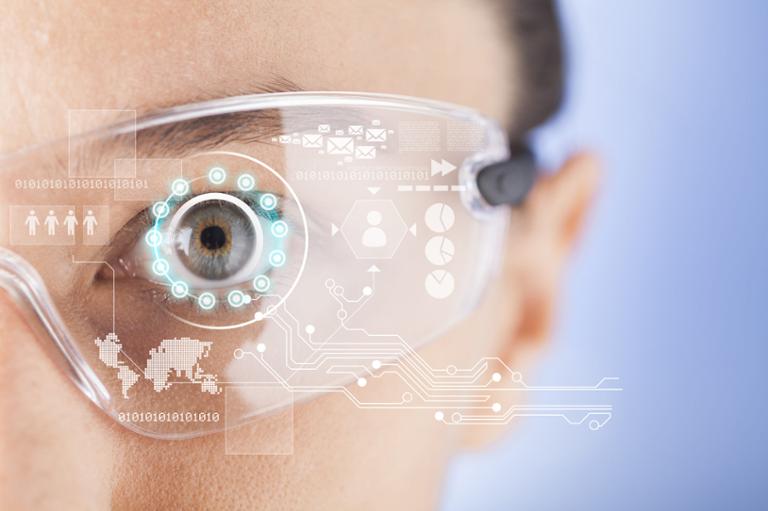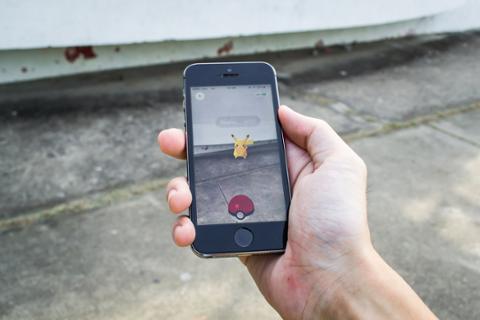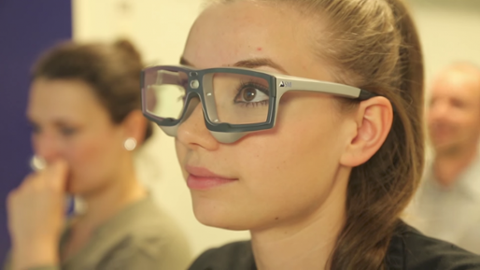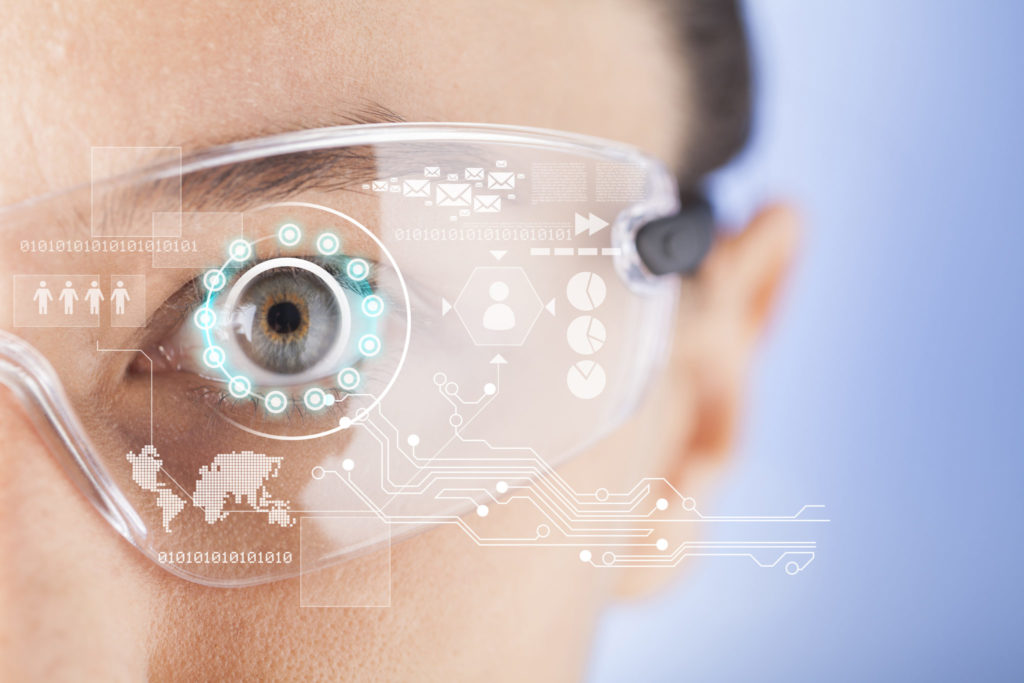
Augmented reality (AR) has become part of our digital culture. With Apple’s
ARKit and Google’s
ARCore making the technology available for mobile devices such as smartphones, it’ll soon become ubiquitous. Most are expecting tech firms to take the next logical step and build AR headsets. But when will that hardware arrive, if ever? In 2013, Google took a primordial stab at AR with
Glass, its heads-up wearable that positioned a small acrylic display just above your right eye. It was fairly revolutionary technology at the time: small snippets of info overlaid on your environment could provide value-added context to your day-to-day routine. Although the initial version of Glass faltered, other companies have taken increasingly sophisticated stabs at dedicated AR hardware. Arguably the most prominent example is Microsoft’s HoloLens: a bulky, wired device that can serve up AR and VR functionality (although most of Microsoft's onstage demos have focused on AR). When I experimented with it at Microsoft's Build 2016 conference, company reps guided me (and other members of the press) through a small cooperative game. It offered a solid AR experience. [caption id="attachment_136828" align="aligncenter" width="759"]
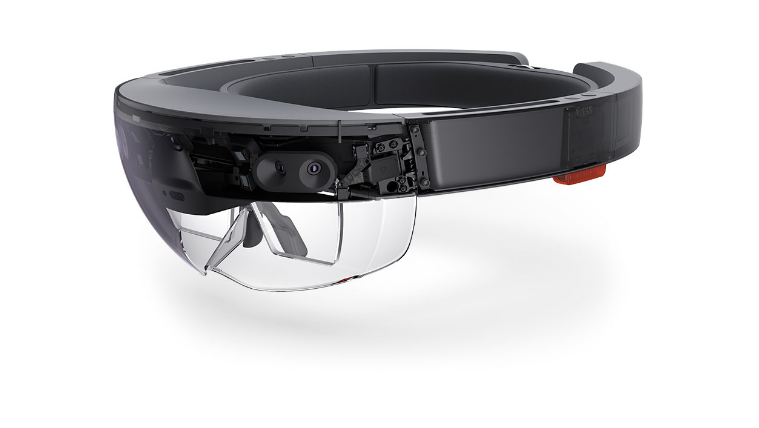
HoloLens[/caption] HoloLens
hasn't yet made it out of beta; it’s still not for sale beyond Microsoft’s
developer platform. At the moment, Microsoft seems more intent on pushing "mixed reality" headsets that are more VR than AR. At Build 2017, Microsoft made the case that virtual and augmented reality were essentially the same thing, which seemed like a sign it knew ‘mixed reality’ wasn't going to win any branding wars. With slow progress on headsets, it seems the tech industry is now focused on importing AR to smartphones. Apple’s ARKit made its way to iPhones and iPads everywhere with the release of iOS 11. It’s the first mainstream foray into augmented reality, and, thanks to the ubiquity of iOS devices, provides developers with a huge potential install base right away. (Google’s ARCore is still in beta, but it’ll do for Android what ARKit does for iOS.) There are other signs that headsets aren't on the verge of becoming a breakout technology. Intel recently
shelved its own VR/AR headset, which it tried to brand as ‘merged reality.’ Snap Inc’s Spectacles, which was potentially a hardware in-road for AR via the Snapchat app, have suffered
diminishing sales figures. Epson’s
Moverio glasses linger, but don’t figure into any AR conversation. [caption id="attachment_116804" align="aligncenter" width="600"]
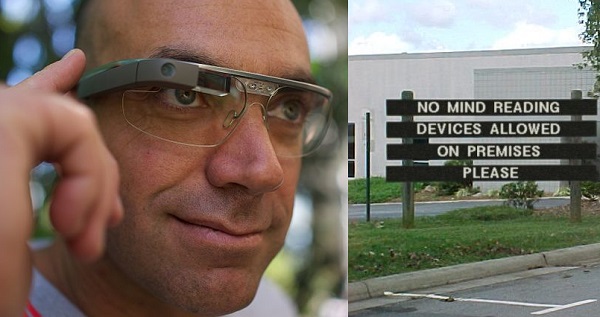
Google Glass... can't read minds. Or can it?![/caption] Before ARKit even launched, many expected Apple to release an AR headset. It didn’t materialize this year, and now we know why. As CEO Tim Cook said in a recent interview with The Independent: "There are
rumors and gossip about companies working on that, and we obviously don't talk about
what we work on. But today I can tell you that the technology itself doesn't exist to do that in a quality way. The display technology required, as well as putting enough stuff around your face – there’s huge challenges with that. The field of view, the quality of the display itself, it’s not there yet." With that statement, Cook summed up the AR wearable industry: it’s not ready for the use-cases we need. The simplest example of where AR works well is
an app that replaces a tape measure; if you tried that with a headset instead of a phone, there'd be no easy way to designate a start or stop point for the measurements. At a minimum, AR needs gesture recognition, and it’s just not there yet. Nonetheless, tech firms are still experimenting with a way forward on that front. A
patent filed earlier this year by Apple brings gestures and interactions to heads-up AR displays. If Apple can transform the technology suggested by the patent into reality, it may have a profound effect. Long story short:
really good AR headsets are probably coming at some point. While the initial pushes have been middling, technologies such as ARKit and AR Core provide a solid foundation to build upon. If AR has the long-term impact that many expect, Google’s vision of people wearing a heads-up display rather than staring at their phones could come to fruition. It just won't come via Glass.
 Augmented reality (AR) has become part of our digital culture. With Apple’s ARKit and Google’s ARCore making the technology available for mobile devices such as smartphones, it’ll soon become ubiquitous. Most are expecting tech firms to take the next logical step and build AR headsets. But when will that hardware arrive, if ever? In 2013, Google took a primordial stab at AR with Glass, its heads-up wearable that positioned a small acrylic display just above your right eye. It was fairly revolutionary technology at the time: small snippets of info overlaid on your environment could provide value-added context to your day-to-day routine. Although the initial version of Glass faltered, other companies have taken increasingly sophisticated stabs at dedicated AR hardware. Arguably the most prominent example is Microsoft’s HoloLens: a bulky, wired device that can serve up AR and VR functionality (although most of Microsoft's onstage demos have focused on AR). When I experimented with it at Microsoft's Build 2016 conference, company reps guided me (and other members of the press) through a small cooperative game. It offered a solid AR experience. [caption id="attachment_136828" align="aligncenter" width="759"]
Augmented reality (AR) has become part of our digital culture. With Apple’s ARKit and Google’s ARCore making the technology available for mobile devices such as smartphones, it’ll soon become ubiquitous. Most are expecting tech firms to take the next logical step and build AR headsets. But when will that hardware arrive, if ever? In 2013, Google took a primordial stab at AR with Glass, its heads-up wearable that positioned a small acrylic display just above your right eye. It was fairly revolutionary technology at the time: small snippets of info overlaid on your environment could provide value-added context to your day-to-day routine. Although the initial version of Glass faltered, other companies have taken increasingly sophisticated stabs at dedicated AR hardware. Arguably the most prominent example is Microsoft’s HoloLens: a bulky, wired device that can serve up AR and VR functionality (although most of Microsoft's onstage demos have focused on AR). When I experimented with it at Microsoft's Build 2016 conference, company reps guided me (and other members of the press) through a small cooperative game. It offered a solid AR experience. [caption id="attachment_136828" align="aligncenter" width="759"]  HoloLens[/caption] HoloLens hasn't yet made it out of beta; it’s still not for sale beyond Microsoft’s developer platform. At the moment, Microsoft seems more intent on pushing "mixed reality" headsets that are more VR than AR. At Build 2017, Microsoft made the case that virtual and augmented reality were essentially the same thing, which seemed like a sign it knew ‘mixed reality’ wasn't going to win any branding wars. With slow progress on headsets, it seems the tech industry is now focused on importing AR to smartphones. Apple’s ARKit made its way to iPhones and iPads everywhere with the release of iOS 11. It’s the first mainstream foray into augmented reality, and, thanks to the ubiquity of iOS devices, provides developers with a huge potential install base right away. (Google’s ARCore is still in beta, but it’ll do for Android what ARKit does for iOS.) There are other signs that headsets aren't on the verge of becoming a breakout technology. Intel recently shelved its own VR/AR headset, which it tried to brand as ‘merged reality.’ Snap Inc’s Spectacles, which was potentially a hardware in-road for AR via the Snapchat app, have suffered diminishing sales figures. Epson’s Moverio glasses linger, but don’t figure into any AR conversation. [caption id="attachment_116804" align="aligncenter" width="600"]
HoloLens[/caption] HoloLens hasn't yet made it out of beta; it’s still not for sale beyond Microsoft’s developer platform. At the moment, Microsoft seems more intent on pushing "mixed reality" headsets that are more VR than AR. At Build 2017, Microsoft made the case that virtual and augmented reality were essentially the same thing, which seemed like a sign it knew ‘mixed reality’ wasn't going to win any branding wars. With slow progress on headsets, it seems the tech industry is now focused on importing AR to smartphones. Apple’s ARKit made its way to iPhones and iPads everywhere with the release of iOS 11. It’s the first mainstream foray into augmented reality, and, thanks to the ubiquity of iOS devices, provides developers with a huge potential install base right away. (Google’s ARCore is still in beta, but it’ll do for Android what ARKit does for iOS.) There are other signs that headsets aren't on the verge of becoming a breakout technology. Intel recently shelved its own VR/AR headset, which it tried to brand as ‘merged reality.’ Snap Inc’s Spectacles, which was potentially a hardware in-road for AR via the Snapchat app, have suffered diminishing sales figures. Epson’s Moverio glasses linger, but don’t figure into any AR conversation. [caption id="attachment_116804" align="aligncenter" width="600"]  Google Glass... can't read minds. Or can it?![/caption] Before ARKit even launched, many expected Apple to release an AR headset. It didn’t materialize this year, and now we know why. As CEO Tim Cook said in a recent interview with The Independent: "There are rumors and gossip about companies working on that, and we obviously don't talk about what we work on. But today I can tell you that the technology itself doesn't exist to do that in a quality way. The display technology required, as well as putting enough stuff around your face – there’s huge challenges with that. The field of view, the quality of the display itself, it’s not there yet." With that statement, Cook summed up the AR wearable industry: it’s not ready for the use-cases we need. The simplest example of where AR works well is an app that replaces a tape measure; if you tried that with a headset instead of a phone, there'd be no easy way to designate a start or stop point for the measurements. At a minimum, AR needs gesture recognition, and it’s just not there yet. Nonetheless, tech firms are still experimenting with a way forward on that front. A patent filed earlier this year by Apple brings gestures and interactions to heads-up AR displays. If Apple can transform the technology suggested by the patent into reality, it may have a profound effect. Long story short: really good AR headsets are probably coming at some point. While the initial pushes have been middling, technologies such as ARKit and AR Core provide a solid foundation to build upon. If AR has the long-term impact that many expect, Google’s vision of people wearing a heads-up display rather than staring at their phones could come to fruition. It just won't come via Glass.
Google Glass... can't read minds. Or can it?![/caption] Before ARKit even launched, many expected Apple to release an AR headset. It didn’t materialize this year, and now we know why. As CEO Tim Cook said in a recent interview with The Independent: "There are rumors and gossip about companies working on that, and we obviously don't talk about what we work on. But today I can tell you that the technology itself doesn't exist to do that in a quality way. The display technology required, as well as putting enough stuff around your face – there’s huge challenges with that. The field of view, the quality of the display itself, it’s not there yet." With that statement, Cook summed up the AR wearable industry: it’s not ready for the use-cases we need. The simplest example of where AR works well is an app that replaces a tape measure; if you tried that with a headset instead of a phone, there'd be no easy way to designate a start or stop point for the measurements. At a minimum, AR needs gesture recognition, and it’s just not there yet. Nonetheless, tech firms are still experimenting with a way forward on that front. A patent filed earlier this year by Apple brings gestures and interactions to heads-up AR displays. If Apple can transform the technology suggested by the patent into reality, it may have a profound effect. Long story short: really good AR headsets are probably coming at some point. While the initial pushes have been middling, technologies such as ARKit and AR Core provide a solid foundation to build upon. If AR has the long-term impact that many expect, Google’s vision of people wearing a heads-up display rather than staring at their phones could come to fruition. It just won't come via Glass. 